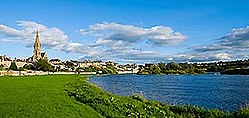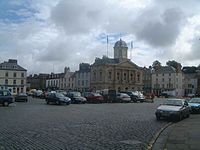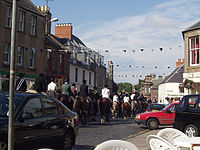Kelso: Difference between revisions
| Line 67: | Line 67: | ||
==Outside links== | ==Outside links== | ||
{{Commons | {{Commons|Kelso, Scottish Borders}} | ||
*[http://www.kelso.bordernet.co.uk/civic-week/songs.html Kelso Songs] | *[http://www.kelso.bordernet.co.uk/civic-week/songs.html Kelso Songs] | ||
*[http://travel.webshots.com/album/558854264RZEFnZ/ Photos of Kelso] | *[http://travel.webshots.com/album/558854264RZEFnZ/ Photos of Kelso] | ||
Latest revision as of 21:27, 30 January 2018
| Kelso | |
| Roxburghshire | |
|---|---|
 Kelso, from the Cobby Tweedside meadow | |
| Location | |
| Grid reference: | NT7268233961 |
| Location: | 55°35’55"N, 2°26’1"W |
| Data | |
| Population: | 6,385 (2001) |
| Post town: | Kelso |
| Postcode: | TD5 |
| Dialling code: | 01573 |
| Local Government | |
| Council: | Scottish Borders |
| Parliamentary constituency: |
Berwickshire, Roxburgh and Selkirk |
Kelso is a modest market town in Roxburghshire at the meeting of the rivers Tweed and Teviot. The parish has a population of 6,385. It is regarded as one of the most charming and quaint towns in the area with its cobbled streets, elegant Georgian buildings and French style cobbled market square.
Kelso's other main tourist draws are the ruined Kelso Abbey and Floors Castle, a house designed by William Adam and completed in 1726. The bridge at Kelso was designed by John Rennie, who later built London Bridge.
The town's name is from the location of the earliest village, on a chalky outcrop standing high above the river. In Old English Cealchoh means "chalk hill", a description of the site.
History

Kelso stands on the opposite bank of the River Tweed from the now-vanished royal burgh of Roxburgh, which gave its name to the county. Kelso and its sister hamlet of Wester Kelso were linked to the burgh by a ferry at Wester Kelso.
The origin of today's town is in the creation of Kelso Abbey in 1128. A hamlet existed before the completion of the Abbey in that year but the village started to flourish with the arrival of the monks, whose custom brought workmen and tradesmen to the newly growing town. The Abbey controlled much of life in Kelso area, a burgh of barony, called Holydean, until the Reformation in the 16th century.
Neighbouring Roxburgh had separate fortunes which must have been watched across the river, for while Kelso was known for its monks, Roxburgh was a castle town, changing hands often and held by the English for much of the Middle Ages, and eventually rased to the ground. Kelso was spared.
At the Reformation, Kelso Abbey was dissolved. The Kerr family of Cessford took the barony over and many of the Abbey's properties around the town. By the 17th century, they virtually owned Kelso.
In Roxburgh Street, outside the Haldanes supermarket, is the outline of a horseshoe petrosomatoglyph where the horse of Charles Edward Stuart, the Young Pretender, cast a shoe as he was riding it through the town on his way to Carlisle in 1745. He is also said to have planted a white rosebush in his host's garden, descendants of which are still said to flourish in the neighbourhood.[1]
About the town

Kelso is unique in Scotland for having a cobbled square fed by four cobbled streets
According to a letter dated 17 October 1788, 'The workmen now employed in digging the foundations of some religious houses which stood upon St. James' Green, where the great annual fair of that name is now held in the neighbourhood of this town, have dug up two sone [sic] coffins of which the bones were entire, several pieces of painted glass, a silver coin of Robert II, and other antique relics'.
Floors Castle
Floors castle is a large stately home just outside Kelso. It is a popular visitor attraction amongst the Middle Shires. Adjacent to the house there is a fabulous walled garden with a cafe, a small garden centre and the Star Plantation.
Community
The town has much sport and recreation, the River Tweed at Kelso is renowned for its salmon fishing.
There are two eighteen-hole golf courses as well as a National Hunt (steeplechase) horse racing track, the course is known as "Britain's Friendliest Racecourse". Racing first took place in Kelso in 1822.
Events

Common Riding and Civic Week
Every year in July, the town celebrates the border tradition of Common Riding, known as Kelso Civic Week. The festival lasts a full week and is headed by the Kelsae Laddie with his Right and Left Hand Men.
The Laddie and his followers visit neighbouring villages on horseback with the climax being the Yetholm Ride on the Saturday. There are many competitions and social events every day.
There have been many songs written about Kelso (or Kelsae), (most notably "Kelsae Bonnie Kelsae") but the most recent one is "Yetholm Day", composed by Gary Cleghorn, a young follower of Civic Week for many years. The song tells the story of the Kelsae Laddie and his followers on the Saturday ride-out to Kirk Yetholm and Town Yetholm.
As a fund-raiser for Kelso Civic Week, Gary Cleghorn involved Ex Laddies and locals to sing some of the old Kelso songs, plus some new songs by local artists, on a CD, "Songs of Kelso", which is sold in the town by local shops and public houses.
Annual fair
Every first weekend of September, Kelso hosts its annual fair. The weekend includes dancing, street entertainers, live music, stalls , free music concert. The Fair attracts around over the whole weekend around 10,000 people to the town.
People
Sir Walter Scott attended Kelso Grammar School in 1783 and he said of the town, "it is the most beautiful if not the most romantic village in Scotland". Another attraction is the Cobby Riverside Walk which goes from the town centre to Floors Castle along the banks of the Tweed passing the point where it is joined by the River Teviot. Kelso has two bridges that span the River Tweed, "Rennie's Bridge" was completed in 1803 to replace an earlier one washed away in the floods of 1797, it was built by John Rennie of Haddington, who later went on to build Waterloo Bridge in London, his bridge in Kelso is a smaller and earlier version of Waterloo Bridge. The bridge was the cause of local rioting in 1854 when the Kelso population objected to paying tolls even when the cost of construction had been covered, the Riot Act was read, three years later tolls were abolished. Hunter's Bridge, half a mile downstream, is a modern construction built to take much of the heavy traffic that has damaged Rennie's bridge by diverting vehicles around the town.
Famous people from Kelso have included civil engineer Sir James Brunlees (1816–1892) who constructed many railways in the United Kingdom as well as designing the docks at Avonmouth and Whitehaven. Sir William Fairbairn (1789–1874) was another engineer who built the first iron hulled steamship the Lord Dundas and built over 1,000 bridges using the tubular steel method which he pioneered. Thomas Pringle the writer, poet and abolitionist, was born at nearby Blakelaw, a 500-acre farmstead four miles to the south of the town where his father was the tenant.
Outside links
| ("Wikimedia Commons" has material about Kelso) |
References
- ↑ Westwood, Jennifer (1985), Albion. A guide to Legendary Britain. Pub. Grafton Books. London. ISBN 0-246-11789-3. P. 378.
